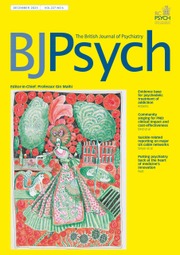We read with interest the article by Pillmann & Marneros (Reference Pillmann and Marneros2005). Acute and transient psychosis is a common clinical presentation in the developing world. We retrieved medical records of all patients with psychotic disorders (F06.0–06.3, F20–29, F30.2, F31.2, F31.5, F32.3, F33.3) who attended our unit from 1 January to 30 September 2003. There were 87 patients (13.9%) with a diagnosis of acute psychosis (ICD–10 F23). The majority were young adults (mean age 29.75 years, s.d.=10.95), male (52%) and without a history of precipitating stress (71%) or similar illness (93%). The mean duration of follow-up was 13.2 months (s.d.=11.7). The diagnosis was revised to affective disorder in 8 patients (9.2%), schizophrenia in 23 (26.4%), and 10 patients (11.5%) presented with recurrent episodes of acute psychosis.
The high drop-out rate has been attributed to a good response to antipsychotic medication, spontaneous remission and/or preference for indigenous treatments (Reference Raguram, Venkateswaran and RamakrishnaRaguram et al, 2002). Most studies of acute psychosis have small samples (Reference Susser, Varma and MattooSusser et al, 1998; Reference Marneros, Pillmann and HaringMarneros et al, 2003; Reference Pillmann and MarnerosPillmann & Marneros, 2003; Reference Singh, Burns and AminSingh et al, 2004) and there are no large long-term follow-up studies of acute psychosis from the developing world.
The introduction of the categories acute and transient psychotic disorders in ICD–10 and brief psychotic disorder in DSM–IV has allowed for coding of patients with a single episode of illness. However, there is also a need to categorise people who present recurrently with such episodes. Future classification should consider such a category.
Acute psychotic presentations can be secondary to organic psychoses and substance dependence. Psychiatrists often subscribe to the Kraepelinian dichotomy and attempt to label all functional psychosis as schizophrenia or affective disorders. However, clinical presentations of acute psychosis challenge such categorisation. Although many patients recover, some relapse with similar acute psychotic presentations, and a significant proportion also develop classic schizophrenia and mood disorders. The difficulty in reaching a diagnosis at the time of the initial presentation is because it is often difficult to recognise the classic syndromes at the onset of the illness. However, these can be identified over time as they become more obvious. Thus, acute psychoses can be a presentation of organic psychoses, substance-induced disorders, schizophrenia, schizophrenia, affective illness or may be ‘micro-psychotic’ episodes that occur in some personality disorders. They can also be separate clinical entities. Clinicians working in the developing world are often aware of this distinction.



eLetters
No eLetters have been published for this article.